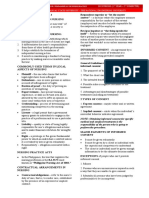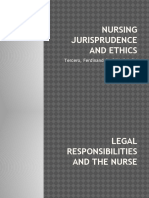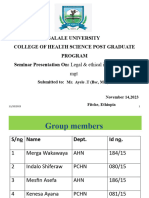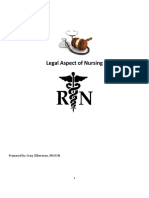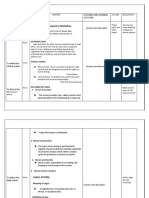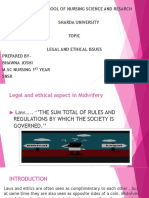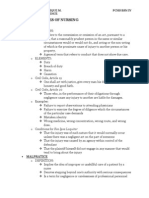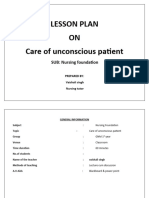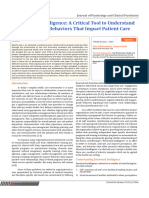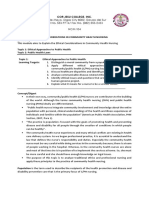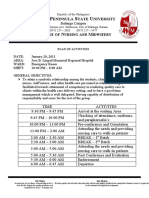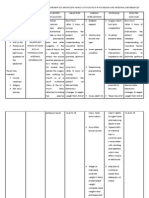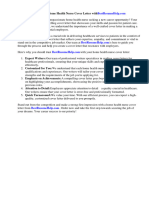Chapter Two Legal and Ethical Aspects of
Nursing
Objective
1. Summarize the structure and function of the legal system.
a. Criminal Law
i. Conduct at issue is offensive to society in general.
ii. Conduct at issue is detrimental to society.
iii. The law involves public offenses (such as robbery, murder,
assault).
iv. The law’s purpose is to punish for the crime and deter and
prevent further crime.
b. Civil Law
i. Conduct at issue violates a person’s rights.
ii. Conduct at issue is detrimental to that individual.
iii. The law involves an offense that is against an individual.
iv. The law’s purpose is to make the aggrieved person whole
again, to restore the person to where he or she was.
2. Compare and contrast nursing negligence and malpractice.
a. Negligence refers to the absence of due care. It is more of a
general action that often can be attributed to being careless.
Nurses and unlicensed assistive personnel may be charged with
negligence. Negligence refers to the failure to act in a manner
demonstrating the care and knowledge any prudent individual
would.
b. Malpractice refers to professional negligence. Nursing
responsibilities include actions taken and those omitted. The
concept of malpractice must contain four key elements. Each of
the elements must be present for liability to be established.
i. Duty refers to the established relationship between the
patient and the nurse.
ii. Breach of duty is failure to perform the duty in a
reasonable, prudent manner.
iii. Harm has occurred; this does not have to be physical
injury.
iv. The breach of duty was the proximate cause of the harm;
the occurrence of harm depended directly on the
occurrence of the breach.
3. Discuss the legal relationships that exist between the nurse and the
patient.
� When a nurse accepts a patient care assignment, the nurse-patient
relationship is initiated. This relationship, beyond its more personal
human component, has a legal basis: the duty to provide professional
care. A failure to provide care to the expected level of expertise gives
rise to legal liability. In the nurse-patient relationship, the nurse
accepts the role of advocate for the patient.
4. Explain the importance of maintaining standards of care.
They define the obligations of the nurse, including those activities that
are obligatory and those that are prohibited. Failure to adhere to these
standards gives rise to legal liability. Ignorance of the requirements and
limitations does not absolve liability.
5. Give examples of ways the nursing profession is regulated.
a. Standards of care
i. Derive from federal and state laws, rules, and regulations
and codes that govern other professional agencies and
organizations.
1. American Nurses Association (ANA)
b. The laws that formally define and limit the scope of nursing
practice are called the Nurse practice acts.
i. The institution has the right to establish policies and
procedures for nursing activities within the confines of the
state’s nursing practice act.
1. Becomes tricky when doing multiple state licensure.
6. Give examples of legal issues in health care.
a. Patients’ rights
b. Informed consent
c. Confidentiality
d. Social media
e. Medical records
f. Invasion of privacy
g. Reporting abuse
7. Discuss federal regulations of the Health Insurance Portability and
Accountability Act of 1996 (HIPAA) privacy rule and its impact on the
health care system.
a. Health care institutions are obligated to uphold the patient’s
rights to
i. Access to health care without any prejudice
ii. Treatment with respect and dignity always
iii. Privacy and confidentiality
iv. Personal safety
v. Complete information about one’s own conditions and
treatment.
� b. Patient’s responsibilities to the health care institution include.
i. Providing accurate information about themselves
ii. Giving information’s regarding their known conditions
iii. Participating in decision making regarding treatment and
care
8. Five examples of ways the licensed practical/vocational nurse can
avoid being involved in a lawsuit.
a. Open and honest communication
b. Following standards of care
c. Following the policies and procedures of the facility
d. Adhering to the scope of practice
e. Remaining current on practice developments and taking
advantage of continuing education opportunities
9. Differentiate between a legal duty and an ethical duty.
a. Legal duties for the nurse include proper use of equipment,
proper documentation, Standards of care and patient advocacy.
b. Ethical Duty is acting in the patient’s best interest by providing
care that meets and is consistent with all established legal
standards and principles.
c. the nurse has a legal and ethical obligation to safeguard their
patients’ best interests.
10. Explain advance directives.
a. Signed and witnessed documents that provide specific
instructions for health care treatment if a person is unable to
make these decisions personally at the time they are needed.
The two basic types of advance directives are living wills and
durable powers of attorney for health care.
i. Under the act, whether the patient has signed an advance
directive must be documented in the patient’s record.
11. Summarize how culture affects on individual’s beliefs, morals,
and values.
a. Culture is learned as the individual grows up and is influenced by
the surrounding environment. The nurse must be aware of
cultural differences and should avoid:
i. Transferring personal expectations to patients
ii. Generalizing based on personal views.
iii. Assuming patients can understand what is being said just
because they speak English
iv. Treating each patient, the same
To meet patients’ needs, respect for their cultural heritage is
vital.
12. Identify how values affect decision making.
� a. Values influence everyday decisions. Each person has many
values and at times must choose between competing or
conflicting values. Some values are consciously chosen; others
are adopted unconsciously. To clarify values, do the following:
i. Select the belief or behavior and consciously examine it.
ii. Decide its value.
iii. Incorporate the value into everyday responses and
behaviors.
13. Distinguish between ethical and unethical behavior.
a. Unethical behavior involves failing to perform the duties of a
competent, caring nurse.
b. Ethical behavior begins with respect for people, autonomy,
Beneficence, and justice.
14. Explain the meaning of a code of ethics.
a. The code specifies what is expected:
i. To know and function within the scope of practice for a
licensed LPN/LVN
ii. To maintain patient confidences
iii. To provide health care without discrimination
iv. To maintain a high degree of professional and personal
behavior
v. To take an active role in the development of the LPN/LvN
profession
15. Explain the nurse’s role in reporting unethical behavior.
a. Puts the patient or facility at risk.
b. Demonstrates incompetence.
c. Involves the use of alcohol or drugs.
d. Is related to a physical or mental condition.
e. Violates a nursing statute.
16. Give examples of ethical issues common in health care.
a. Ethical issues change as society changes. Some of the current
ethical issues in nursing include practitioner- assisted suicide, the
right to refuse treatment, the nurse’s right to refuse to provide
care, and genetic research.
Key Terms
1. Accountability
Being answerable for one’s own actions.
2. Advocate
A person who acts on behalf of another person.
3. Deposition
Out-of-court, under oath statement of a witness.
�4. Doctrine of informed consent
The requirements of a physician to provide information to the patient
about a procedure that will include both the risks and benefits of the
intervention planned.
5. Ethical dilemmas
Situation that does not have a clear correct or incorrect answer.
6. Ethics
The way one should behave, how a person ought to act.
7. Euthanasia
Deliberately bringing about the death of an individual suffering from an
incurable disease or condition; can be done actively or passively.
8. Laws
The reference of a rule, principle, or regulation established and made
known by a government to protect or restrict the people affected.
9. Liability
A legal concept that holds a person legally responsible for harm caused
to another person or property.
10. Liable
Legally responsible
11. Malpractice
Professional misconduct: behavior that fails to meet the standard of
care.
12. Nonmaleficence
Ethical principle meaning “to do no harm”.
13. Standards of care
Those acts that are permitted to be performed or prohibited from being
performed by a prudent person working within the limits of the
training, licensing, experience, and conditions existing at the time of
the duty to give care.
14. Value clarification
A process of self-inspection to identify one’s own beliefs, morals, and
values.
15. Values
Individual’s intrinsic (or personal) beliefs about the importance of a
particular idea, object, or custom that will influence behavior.
16. Verdict
Decision rendered based on the facts of a case, evidence and
testimony presented, credibility of witnesses, and laws pertaining to
the case.

















